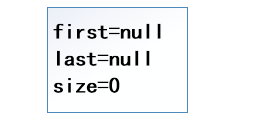一、节点

//节点的数据结构 private static class Node<E> { E item; //元素 Node<E> next; //后继 Node<E> prev; //前驱 Node(Node<E> prev, E element, Node<E> next) { this.item = element; this.next = next; this.prev = prev; } }
二、构造函数
//无参构造函数 public LinkedList() { } //构造一个包含指定集合的元素的列表 public LinkedList(Collection<? extends E> c) { this(); addAll(c); }

插入一个元素后,first和last都指向这个元素

/** * index :Collection第一个元素插入的位置 */ public boolean addAll(int index, Collection<? extends E> c) { //检测下标的合法性 checkPositionIndex(index); Object[] a = c.toArray(); int numNew = a.length; if (numNew == 0) return false; Node<E> pred, succ; //集合中没有一个元素,讲前驱节点指向last,后继为null if (index == size) { succ = null; pred = last; } else { //获取index位置的节点,后继节点为当前的节点,前驱节点为当前节点的前驱节点。 succ = node(index); pred = succ.prev; } for (Object o : a) { @SuppressWarnings("unchecked") E e = (E) o; //建立新的节点 Node<E> newNode = new Node<>(pred, e, null); if (pred == null) first = newNode; else pred.next = newNode; pred = newNode; } if (succ == null) { last = pred; } else { pred.next = succ; succ.prev = pred; } size += numNew; modCount++; return true; }
获取指定位置的节点
/** * 如果index在集合的前半部分则从前边遍历, * 如果在集合的后半部分则从后边遍历。提高效率。 */ Node<E> node(int index) { if (index < (size >> 1)) { Node<E> x = first; for (int i = 0; i < index; i++) x = x.next; return x; } else { Node<E> x = last; for (int i = size - 1; i > index; i--) x = x.prev; return x; } }
将元素添加到首尾元素
//将元素添加为首元素 private void linkFirst(E e) { final Node<E> f = first; final Node<E> newNode = new Node<>(null, e, f); first = newNode; if (f == null) last = newNode; else f.prev = newNode; size++; modCount++; } //将元素作为尾元素 void linkLast(E e) { final Node<E> l = last; final Node<E> newNode = new Node<>(l, e, null); last = newNode; if (l == null) first = newNode; else l.next = newNode; size++; modCount++; }